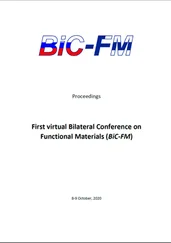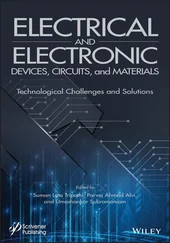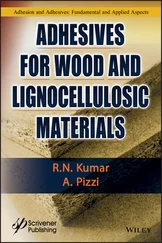Jing-Feng Li - Lead-Free Piezoelectric Materials
Здесь есть возможность читать онлайн «Jing-Feng Li - Lead-Free Piezoelectric Materials» — ознакомительный отрывок электронной книги совершенно бесплатно, а после прочтения отрывка купить полную версию. В некоторых случаях можно слушать аудио, скачать через торрент в формате fb2 и присутствует краткое содержание. Жанр: unrecognised, на английском языке. Описание произведения, (предисловие) а так же отзывы посетителей доступны на портале библиотеки ЛибКат.
- Название:Lead-Free Piezoelectric Materials
- Автор:
- Жанр:
- Год:неизвестен
- ISBN:нет данных
- Рейтинг книги:5 / 5. Голосов: 1
-
Избранное:Добавить в избранное
- Отзывы:
-
Ваша оценка:
- 100
- 1
- 2
- 3
- 4
- 5
Lead-Free Piezoelectric Materials: краткое содержание, описание и аннотация
Предлагаем к чтению аннотацию, описание, краткое содержание или предисловие (зависит от того, что написал сам автор книги «Lead-Free Piezoelectric Materials»). Если вы не нашли необходимую информацию о книге — напишите в комментариях, мы постараемся отыскать её.
Lead-Free Piezoelectric Materials
Lead-Free Piezoelectric Materials
Lead-Free Piezoelectric Materials — читать онлайн ознакомительный отрывок
Ниже представлен текст книги, разбитый по страницам. Система сохранения места последней прочитанной страницы, позволяет с удобством читать онлайн бесплатно книгу «Lead-Free Piezoelectric Materials», без необходимости каждый раз заново искать на чём Вы остановились. Поставьте закладку, и сможете в любой момент перейти на страницу, на которой закончили чтение.
Интервал:
Закладка:
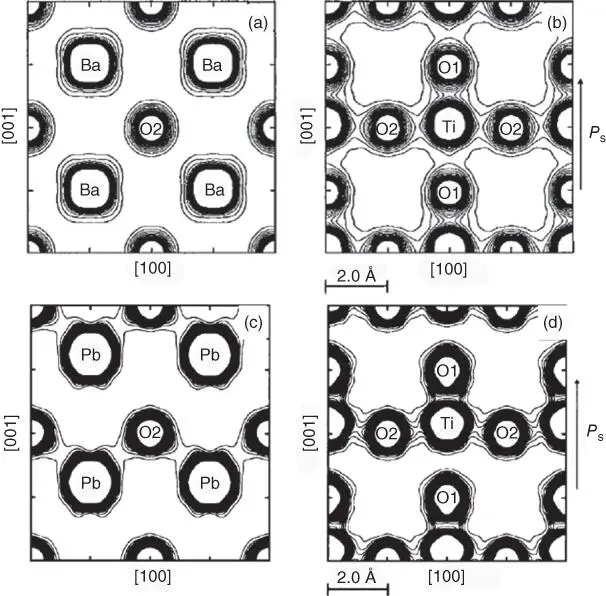
Figure 2.3 Charge‐density distributions on (a) the (010) plane (Ba–O plane), (b) the (020) plane (Ti–O plane) of tetragonal BaTiO 3at 300 K, compared to that of tetragonal PbTiO 3at 300 K on (c) the (010) plane (Pb–O plane), and (d) the (020) plane (Ti–O plane).
Source: Reprinted with permission from Kuroiwa et al. [20]. Copyright 2001, American Physical Society.
2.3 (K,Na)NbO 3
(K,Na)NbO 3(shortened as KNN) is a solid solution of KNbO 3and NaNbO 3. KNbO 3is a ferroelectric material with T c= 435 °C, while NaNbO 3is expected to an antiferroelectric material with T c= 640 °C according to the early studies; evidences for the latter's antiferroelectricity are still being investigated. Nevertheless, both compounds can form solid solutions in the full compositional range, analogous to the PZT system that is a solid solution of ferroelectric PbTiO 3and antiferroelectric PbZrO 3[21].
(K,Na)NbO 3ceramics have been investigated quite early, which was found as a piezoelectric material in 1950s. Jaeger and Egerton [22] fabricated highly dense KNN ceramics using hot pressing and reported that the hot‐pressed KNN ceramics possessed high piezoelectric constants and Curie temperature. However, since then there had been only a few reports about piezoelectricity of NaNbO 3, KNbO 3, or KNN ceramics, probably because of their poor sinterability and high volatility, in addition to their low piezoelectricity compared with the PZT ceramics that have been widely used so far. KNN ceramics have begun to attract special attention again because of a breakthrough made by Saito et al., who obtained high d 33(~416 pC/N) in textured KNN‐based ceramics [10]. Their work not only revealed the potentials of KNN ceramics as a promising candidate for lead‐free piezoelectric ceramics, but also stimulated widespread scientific interest in developing lead‐free piezoceramics.
Figure 2.4shows the phase diagram of the KNN system [23]. It is quite complicated when compared with the PZT system. Similar to KNbO 3, the KNN shows the following polymorphisms within a wide composition range: low temperature (less than −10 °C) rhombohedra (R) phase, room‐temperature orthorhombic (O) phase, high temperature tetragonal (T, 225~435 °C), and cubic (C, >435 °C) phase. However, the phase transitions of NaNbO 3are even more complicated, exhibiting seven polymorphs across the whole temperature range. The temperature‐dependent phase transition of KNN is similar to the case of BaTiO 3, but the cubic to non‐cubic phase transition temperature in the former, corresponding to the Curie temperature, is much higher than that of BaTiO 3, which is a major advantage of KNN. Therefore, KNN‐based ceramics are considered as the most promising lead‐free piezoceramics with good comprehensive performance (large d 33and high T C).
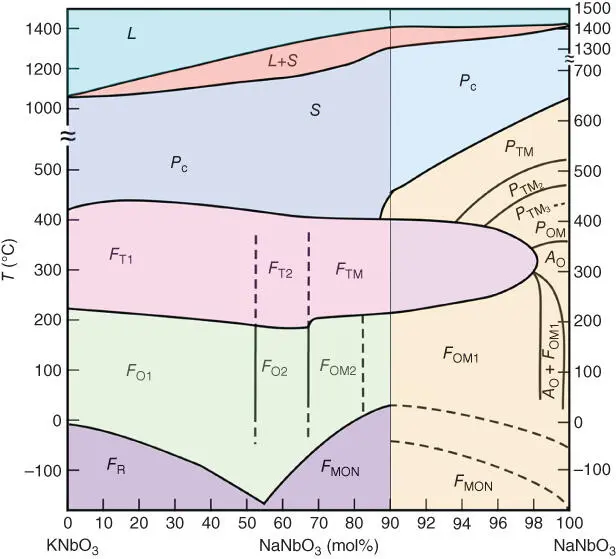
Figure 2.4 Phase diagram of KNbO 3–NaNbO 3system.
Source: Reprinted with permission from Li et al. [23]. Copyright 2013, John Wiley & Sons, Inc.
Significant research progress on KNN‐based ceramics has been achieved in the past years [23–26]. The record d 33of the textured KNN‐based ceramics has been boosted to 704 pC/N in 2018 [27] from the original report of 412 pC/N by Saito et al. in 2004 [10]. Phase boundary engineering is an effective approach to the piezoelectricity enhancement in KNN. Pristine KNN has an orthorhombic phase (O) at room temperature, which transfers to rhombohedral (R) and tetragonal (T) phases at approximately −200 and 200 °C, respectively. Shifting these phase transition temperatures to room temperature by chemical modification has proved to be an effective way to enhance the piezoelectric performance of KNN materials significantly. That is, these two or three phases can be rendered to co‐exist near at room temperature, thereby leading to enhanced piezoelectricity. Such an enhancement is based on the polymorphic phase transition (PPT) effect, which is different from the classic MPB effect. The high piezoelectricity of KNN‐based ceramics deriving from the PPT effect, however, is sensitive to temperature changes [23, 28]; small variations from room temperature can lead to significant drops in the piezoelectricity. Therefore, a simultaneous enhancement of the piezoelectricity and its thermal stability has been one of the focused topics, which is crucial for extending the large‐scale applications of KNN‐based piezoceramics. An effective strategy to this end is making the phase transition boundary diffused [29–31], which will be described later in the corresponding chapter. In addition to the outstanding overall piezoelectric performance, another advantage of the KNN‐based ceramics is their compatibility of co‐firing with Ni electrodes that are much cheaper than Ag/Pd electrodes currently used for PZT multilayer piezoelectric ceramics [32].
2.4 (Bi 1/2Na 1/2)TiO 3
(Bi 1/2Na 1/2)TiO 3(abbreviated as BNT or NBT) is another important lead‐free piezoelectric material with a perovskite structure. Discovered by Smolenskii et al. in 1961 [33], BNT had been considered as a promising lead‐free piezoelectric material system [34, 35]. BNT shows strong ferroelectric properties at room temperature, including a large remnant polarization P r= 38 μC/cm 2and a coercive field E c= 73 kV/cm [36]. Due to the poor sintering property of the pure BNT ceramics and the relatively low piezoelectric constant ( d 33~ 100 pC/N), many studies have thus focused on improving the piezoelectric properties through cation substitution at the A and/or B sites of BNT [36–38].

Figure 2.5 (a) Phase diagram of of (Bi 1/2Na 1/2)TiO 3–BaTiO 3proposed by Takenaka and (b) compositional dependence of dielectric constant.
Source: Reprinted with permission from Takenaka et al. [35]. Copyright 1991, The Physical Society of Japan.
Takenaka and his research group had done extensive investigations about BNT‐based lead‐free piezoceramics. In 1991, they obtained the phase diagram of the BNT and BaTiO 3solid solution based on the combined measurement results of X‐ray diffraction patterns and dielectric and ferroelectric properties [35]. Most importantly, as shown in Figure 2.5, there exists an MPB between BNT and BaTiO 3at the composition close to 6 mol% BaTiO 3. Separated by this phase boundary are the rhombohedral and tetragonal phases, similar to that in PZT. Therefore, it is also possible to enhance the piezoelectric properties of BNT‐based ceramics by utilizing the MPB effect via compositional modification. However, the BNT–BaTiO 3phase diagram has obtained several newer versions due to the incorporation of other characterization methods [39, 40]. A similar system is the solid solution between (Bi 1/2Na 1/2)TiO 3and (Bi 1/2K 1/2)TiO 3compounds, first reported by Sasaki et al. [41]. The MPB between BNT (rhombohedral) and (Bi 1/2K 1/2)TiO 3(tetragonal) exists in the range of 16–20 mol% (Bi 1/2K 1/2)TiO 3[41].
(Bi 1/2Na 1/2)TiO 3is an interesting system. The structural description of BNT is quite complicated, and some details of the structure are still under debate [36]. Although it is generally agreed that BNT at room temperature is rhombohedral as indicated in the phase diagram, the high‐resolution X‐ray measurements of single crystals also revealed the hints of a monoclinic phase [42]. Some studies also indicate that BNT has a composite structure at nanoscale, namely, the dispersion of short‐range‐ordered orthorhombic phase domains within a long‐range‐ordered rhombohedral or monoclinic phase matrix. The complexity may stem from the fact that there exist two kinds of ions with different valances at the A‐site of the perovskite structure. In addition, unmodified NBT and BNT‐rich BNT–BaTiO 3ceramics often show relaxor ferroelectric features, although the early phase diagram proposed by Takenaka et al. indicated an antiferroelectric region above a certain temperature as shown in Figure 2.5.
Читать дальшеИнтервал:
Закладка:
Похожие книги на «Lead-Free Piezoelectric Materials»
Представляем Вашему вниманию похожие книги на «Lead-Free Piezoelectric Materials» списком для выбора. Мы отобрали схожую по названию и смыслу литературу в надежде предоставить читателям больше вариантов отыскать новые, интересные, ещё непрочитанные произведения.
Обсуждение, отзывы о книге «Lead-Free Piezoelectric Materials» и просто собственные мнения читателей. Оставьте ваши комментарии, напишите, что Вы думаете о произведении, его смысле или главных героях. Укажите что конкретно понравилось, а что нет, и почему Вы так считаете.






